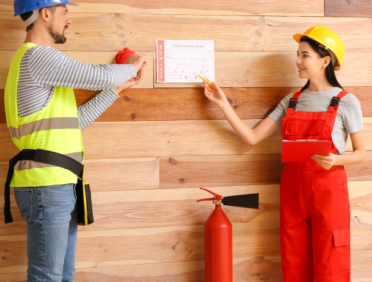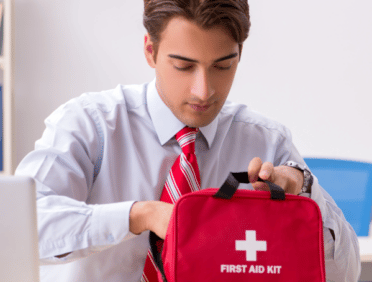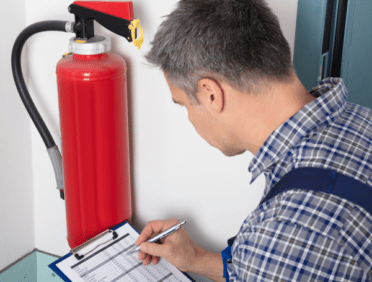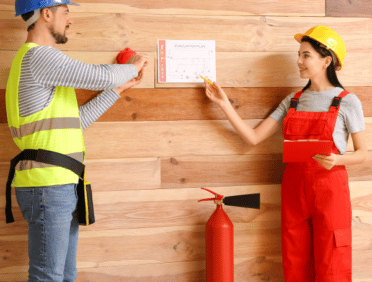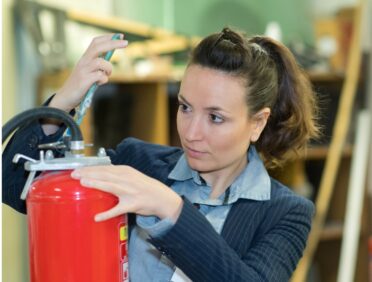The prevalence and potential consequences of fire hazards
A comprehensive guide to identifying, preventing, and managing fire hazards in the UK workplace, ensuring a practical and proactive approach to safety.
Understanding UK Fire Safety Regulations
To understand how best to approach fire safety and ensure that everyone is doing the same things to keep people safe, the UK Fire Safety Regulations were created. These set out the legal obligations for all workplaces and give guidance on how risk assessments should be carried out to protect against fire.
The Regulatory Reform (Fire Safety) Order 2005
Before The Regulatory Reform (Fire Safety) Order 2005 there were a vast amount of different pieces of legislation that, in some way, highlighted aspects of fire safety in non-residential buildings.
This made it very confusing to know where to look for the relevant piece of guidance and meant that fire safety was not always something that was properly achieved in workplaces.
It was decided that things needed to change and the The Regulatory Reform (Fire Safety) Order 2005 was created. This Order took all the pieces from the other legislation and condensed them into one Order.
This made it much easier to follow and ensured that fire safety was a legal obligation within those non-residential buildings.
The legal obligations for fire safety in workplaces
The key legal obligations that relate to fire safety in workplaces are:
- Remove or reduce the risk of fire as much as possible
- Provide general fire precautions
- Ensure that fire safety equipment is operational and maintained properly
- Provide appropriate training to staff
- Prepare and present an emergency plan
- Ensure that everyone is aware of the key duties of those responsible as well as their responsibility
- Review risks regularly
- Record any findings
If you meet these requirements then you will be meeting your legal obligations when it comes to fire safety.
The role of risk assessments in identifying fire hazards
Risk assessments are carried out to determine the level of risk, and when this comes to fire safety, the chance of a fire occurring in a building, or a certain part of a building.
The risk assessment should look at the main threats that are identifiable that could start or increase a fire and find ways to try and mitigate this. The risk assessment should also look at the possible outcomes of a fire happening, identifying the key dangers.
The findings should then be recorded, and, if appropriate, any measures that have been or will need to be taken in the future to keep people in the building safe.
Common Fire Hazards in the Workplace
Fire hazards can come in a variety of forms in one workplace. They can be something that is always there, or it could be something that is an occasional risk. No matter which they are, fire hazards should be identified and measures taken to try and reduce the risk that they pose.
Identification of common fire hazards
The first step in the process is to identify the main fire hazard risks that you may find in your workplace. There are 3 different risks that you may see and each one comes with its dangers and its methods of trying to reduce the risk.
The risks are:
- Electrical Fires
- Flammable Materials
- Equipment
Each one can cause a fire or can make a fire worse, which is why we should be aware of the risks that can be associated with them all.
Explanation of each hazard’s potential to trigger a fire
Electrical fire hazards come in the form of any risk that may come from exposure to electricity. Electrical faults can result in not only an injury to the person but can even cause death. They can also be a leading cause of the fire.
Almost every single business will have electrical fire hazards within their business because they will, in some form, have electrical equipment on site. These hazards can then be caused by a variety of things, including faulty wiring, electrical parts that are exposed and improper use of electrical equipment.
The second risk is flammable materials. Flammable materials can be the thing that turns a small fire into a massive fire that is completely uncontrollable. Flammable materials can be solid materials such as wood and paper, they can also be liquid materials to such as white spirit.
It is incredibly important that you do not store flammable materials anywhere near ignition sources as this could be a dangerous combination.
Finally, we have equipment. Now, most equipment increases the risk of electrical fires occurring, but if they have any form of a heating element within them then this could also be a possible risk factor when it comes to fire safety.
Examples of workplace incidents caused by these hazards
Of course, fire is the main risk that we are going to be looking at when it comes to these fire hazards, however, they can also cause a variety of other issues and incidents too. Electrical fire hazards can cause electric shocks and burns to the skin too.
Risk Assessment and Prevention Strategies
One of the main factors when it comes to fire safety is risk assessment and prevention because this is what will ensure that fires do not have a chance to start in the first place.
Importance of conducting thorough risk assessments
The idea of a risk assessment is that it gives you the chance to look at your building premises and identify the areas that could be seen to be a risk. Conducting risk assessments gives us some idea of what the issues may be and where they are likely to occur.
It is always best to be prepared when it comes to fire safety, any issues that arise, are often easier to fix the earlier that they are picked up on.
A step-by-step guide to assessing fire hazards in the workplace
There are five steps to a risk assessment process when it comes to fire safety. These are:
- Step 1- Identify the fire hazards
- Step 2- Identify the people at risk
- Step 3- Look at your current fire safety measures and decide whether they are adequate or they need improving
- Step 4- Record your findings then use this information to create an emergency plan, ensuring that everyone is aware
- Step 5- Review your fire risk assessments regularly
Step 1- The first thing that you need to do is identify the fire hazards on your premises. You need to look at the potential sources of ignition, and the things that could potentially start the fire, you should then look at whether there are any potential sources of the fire feeding itself and becoming more intense, this can include waste materials and display items.
Next, you should consider oxygen sources, fires need oxygen to burn, so it is essential to identify the potential sources of oxygen within the building. This may come in the form of air conditioning systems or perhaps any other types of oxygen that you may have on-site. You also should take the chance to consider certain structural aspects of your building as these may contribute to the potential spread of the fire. This can include gaps in firewalls, flues and ducts as well as vacant spaces.
Step 2- The next step is identifying the people who are most at risk in the event of a fire. This could be people who are sleeping on the premises, for example, residents of a multi-use building or perhaps staff who work overnight shifts. It should also consider large groups of people, particularly if they gather as this can make evacuation even more complicated.
Another group of people who may be at risk are those who are not used to the building, such as new employees or visitors, they can easily become confused when it comes to leaving the building, particularly if they are in a rush.
Of course, you should also consider those who may find it harder to evacuate out of the building, especially at speed. This includes those who have certain medical conditions, elderly people, young children and those who are disabled too.
When you know who is at risk you can think about the best ways to enable them to get out of the building and to safety.
Step 3- The next stage requires you to look at the potential fire risks in your workplace and then compare them to the measures that you have put in place. You need to decide whether or not there is a low enough risk of fire thanks to the methods that you are using, or if there needs to be some improvements to ensure that the risk is reduced even more.
Step 4- It is important that you always record anything that you have found in your risk assessment, or simply that you performed a risk assessment in the first place. Not only will this be useful when it comes to knowing when your last risk assessment was completed, but it gives you a legal record that you can keep too.
You can use the records that you have created to then create an emergency plan which details what you require everyone in the building to do, should there be a fire suspected or found. This can then be communicated to the entire workplace so that everyone has the information that they need to enable them to evacuate from the building and stay safe.
Step 5- Finally we have the step that many people forget about, once you have completed a risk assessment you don’t just leave it there. You need to repeat your risk assessments regularly. This means that you can find out if any changes within the premises, or just changes in general, have altered whether or not the plans that you have in place are still doing what they need to do.
You should plan to do these not only regularly, but also if there are any obvious changes within the workplace which may impact fire safety.
Implementation of prevention strategies for each identified hazard
Each hazard that you identify will need to have its prevention strategy put into place. This should cover what your plans are to make sure that the risk is reduced as much as it possibly can. There are often strategies that will be repeated across many hazards or that could be tailored to fit each of the different hazards.
Designing Fire-Safe Workspaces
There are many ways to prevent fire as much as possible in your workplace, however, one approach that you can try out for yourself is designing a fire-safe workplace.
Proper layout and arrangement of equipment and materials
Individual workspaces mustn’t become cluttered with a variety of materials and pieces of equipment. Not only can this look messy, but a cluttered space with lots of materials lying around (such as paperwork to do) can be a hazard when it comes to fire. There will be lots of things that are going to feed the fire, along with potential starting points in the way of electrical components. Not always a good mix.
Storage guidelines for flammable substances and hazardous materials
Many workplaces will have both flammable substances or hazardous materials in them, even those that may seem the most run-of-the-mill can be dangerous if they come into contact with fire.
Of course, we can’t just do away with these because they will be needed, but what we can do is think about how they are stored. There needs to be a plan in place that will help employees to work out where flammable substances and hazardous materials are best going to be placed so that if a fire does happen, they are not going to be an additional risk factor to consider.
Ensuring proper ventilation and emergency exits
Emergency exits are something that proves to be vital during an evacuation, so they should be easy to access, clear and in good working order. It is also important to never lock emergency exits, as this can be a huge risk to people being able to escape.
Also, the area should be properly ventilated, as this can help to ensure that should a fire break out, there will be somewhere for the smoke to go and not build up on the premises.
Fire Safety Equipment and Maintenance
It is important to ensure that your premises have fire safety equipment which will allow you to limit the spread or intensity of any fires that happen in your workplace. There are several different pieces of fire equipment that you can have in place, each of which has a different use or benefit.
Essential fire safety equipment
When it comes to fire safety equipment some pieces are essential to have in your premises. These are:
- Alarms
- Extinguishers
- Sprinklers
Alarms allow you to notify everyone in the building that there is a fire on the premises, giving them time to evacuate the premises. They come in a range of forms including those that are visual and audible and those that are linked to smart devices and apps.
Extinguishers are used to try to put out the fire at a close range by a person using them. They come in a variety of types and the extinguisher that you use will depend on the nature of the fire. Some extinguishers are water-based, powder-based, foam-based and also CO2 based too, it is a good idea to make sure that the fire wardens and marshals within the workplace understand the different types and when they should be used. This will hopefully help to put out the fire and not to make the situation worse.
Click here to download your FREE Fire Extinguisher Colour Codes Poster for the workplace
and here to download your FREE How to use a Fire Extinguisher Poster for the workplace
Finally, there are sprinklers, which are used to put out the fire on a large scale and will spray water from the ceiling onto the fire from above. This will help to extinguish the flames and to ensure that the fire doesn’t spread. These are often linked to an alarm system that will turn them on when the alarm detects a possible fire.
Regular maintenance and inspection procedures
Fire equipment can degrade over time, which means that it is important to ensure that you regularly maintain and inspect them. This will allow you to see whether or not there is any wear or tear, which could then potentially impact whether or not the equipment is going to work in the way that you want it to.
This should be something that you plan to do regularly and it is always best to not only have a schedule written up, which will help you to keep track of when it has been maintained, as well as putting together a procedure for how the equipment should be maintained.
Training employees on proper usage and response
Along with installing fire safety equipment on your premises, you also need to make sure that the people on the premises know how to best use them. This will involve specific training on their proper usage.
The main one for this will be fire extinguishers, although it is important to make it clear that the main priority in the case of a fire should always be ensuring that people are evacuated from the building before any efforts to put out the fire begin.
Emergency Response and Evacuation Procedures
Despite your best efforts to limit the chance of a fire developing on your premises, there is always a risk that it can happen. This means that you need to ensure that you have an emergency response and evacuation procedure in place. This will ensure that no matter what happens, everyone in the building is going to have the best chance of evacuating to safety.
Developing and communicating clear evacuation plans
It is vitally important that you have a clear evacuation plan within your workplace that relates to how people will get out when it comes to a fire. This should consider some of the more vulnerable people within your setting and how they will be able to move outside; as well as what support they may need.
This plan should be clear and concise and then it should be communicated to the entire workforce so that they know the process and what they need to do.
Role of designated fire wardens and marshals during emergencies
Both fire wardens and fire marshals should always be aware of what their roles are and what they need to do during an emergency. They should feel comfortable with what is expected of them and be able to stay calm during any emergency.
If there is more than one of either type, then they need to ensure that they work together with the others to ensure that the entire team carry out the evacuation procedure and that the risk of the fire getting worse, spreading or endangering life is reduced.
Conducting regular fire drills and simulations
One of the best ways to find out whether or not a fire evacuation procedure is going to work is to conduct a fire drill. This simulation will help to see what will happen during an emergency and ensure that any changes that need to be made to the plan, can be made.
It is important to carry these out regularly as many things can change within your premises and with the people who work or visit there. This means that whilst one fire drill may have not highlighted any issues that need to be addressed, the next one might.
Continual Improvement and Adapting to Change
Things change over time and fire safety is included in this. It is important that you never become complacent on this subject and that you are always looking to improve and move with the times.
The evolving nature of fire hazards
Fire hazards do change, with more and more equipment being brought into workspaces, all of which can increase risk, as well as different working methods too. This means that just when we think that we have a handle on the fire hazards within our workplace, things can change.
Even subtle changes that we may not think will have much of an impact, such as new staff members or a different price, can bring about changes that impact the fire safety precautions for the entire premises.
Regularly review and update fire safety measures
As fire hazards can change, so should our fire safety measures. This means that we need to take the time to regularly review and update the measures that we have in place. What may have worked some time ago, may not always work, and if we don’t look at the current approaches and assess them against the hazards, we won’t know if this is the case for us.
Adoption of technological advancements in fire prevention
Fire prevention is getting better and smarter over time and we have lots of different approaches now available. This includes smart fire alarms that are linked to apps and a range of fire prevention tools too.
We all must adopt these advancements to ensure that we have the best possible chance of protecting our businesses and everyone within it from a potential fire.
Training and Education for Employees
One final thing that you can do to ensure that you are protected within your premises is to take the time to offer training and education to your employees.
Importance of fire safety awareness among all employees
Whilst some key employees should have a more intensive form of fire safety training, there are benefits to ensuring that all employees have some fire safety awareness training. This will help them to be on the lookout for potential fire risks that others may not have picked up on and will also give them the guidance that they need to allow them to react in the right way during a fire emergency too.
Employee training programmes and resources available in the UK
When it comes to fire safety training it can be delivered in a variety of ways. The two main options are face-to-face, either in your workplace or in another place, or they can be online. There are benefits to both and you need to decide what is going to work best for the staff members that you are looking to train.
Encourage a culture of vigilance and reporting of potential hazards
The main thing that you need to do in your workplace is encourage a culture of not only vigilance so that issues are picked up on, but also of reporting. This means that when a risk is spotted, the staff member who finds it will feel able to highlight this and then take their findings further up the chain.
Fire Safety Training on Learn Q
The Regulatory Reform (Fire Safety) Order 2005 (commonly referred to as the Fire Safety Order) requires that employers and building owners ensure that their employees and relevant persons (such as tenants or visitors) are provided with adequate fire safety training.
Learn Q offer a Fire Safety course that is ideal for the majority of employees and other relevant visitors are fully trained and your business is covered, priced at just £20 per learner.
Alternatively, you can save even more with our money saving bundles, which are ideal for large and smaller businesses, such as:
- COSHH and Fire Safety Training Package | £18.74 | includes COSHH Awareness and Fire Safety
- First Aid and Fire Safety Training Package | £17.51 | includes Emergency First Aid at Work and Fire Safety
- First Aid, COSHH and Fire Safety Bundle | £26.24 | includes Emergency First Aid at Work, COSHH Awareness and Fire Safety
- Health and Safety 5 Course Bundle | £40 | includes Fire Safety, Health and Safety at Work, Display Screen Equipment (DSE) Awareness, Slips, Trips and Falls and RIDDOR (Reporting of Injuries, Diseases and Dangerous Occurrences Regulations) Awareness courses
- Health and Safety at Work 7 Course Training Package | £61.25 | includes Fire Safety, Health and Safety at Work, Display Screen Equipment (DSE) Awareness, Emergency First Aid at Work, COSHH Awareness, Manual Handling and Mental Health: Workplace courses
- Health and Safety in Business Training Package | £33.74 | includes Emergency First Aid at Work, COSHH Awareness, Health and Safety at Work and Fire Safety courses
- Health and Safety in Catering Training Package | £34.99 | includes Emergency First Aid at Work, COSHH Awareness, HACCP Awareness and Fire Safety courses







